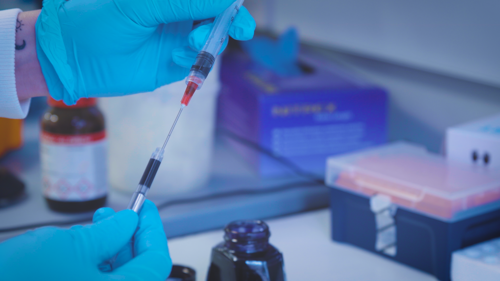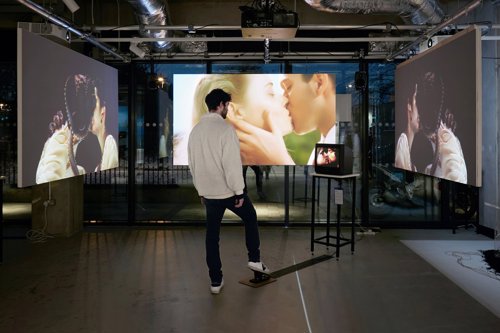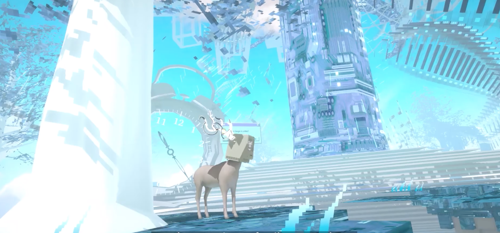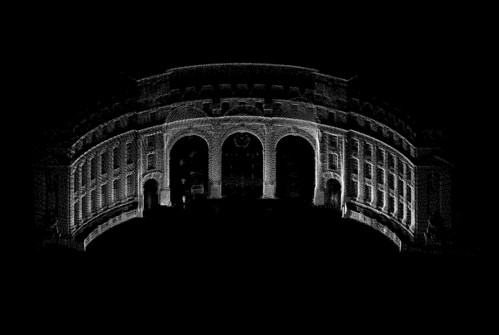On the 8th of November BCS held an evening of presentations and discussion with four Lumen artists at our London offices, facilitated by Goldsmiths University’s Head of Digital Arts Computing Rachel Falconer.
The panel featured 2023 3D/Interactive award winner Sarah Selby and shortlister Max Colson, BCS Futures Award shortlister Adam Cole, and Student Award winner Yuqian Sun. Georgia Smith reports.
3D/Interactive Award Winner: Between the Lines, Sarah Selby
Selby’s Between the Lines ‘seeks to highlight the human experiences behind the numbers and statistics, raising public awareness of the dehumanising nature of the border regime and creating a sense of shared responsibility.’
The use of unregulated AI and automated decision-making algorithms, which reduce individuals to numbers on a page, is on the rise in the UK border regime.
Between the Lines combines the traditional administrative tools of pen and paper with cutting-edge DNA data storage technology to centre the importance of individual experiences. During the project, text documents of written individual experiences were converted into binary data, which was then encoded into synthetic DNA, mixed with writing ink, and injected into pens which were distributed to frontline administrative workers of the UK border regime. Recipients were asked to register their pen via QR codes and sign a form acknowledging the heavy responsibility of their role. The act of writing with the pens transfers the synthetic DNA to the paper, spreading the individuals’ experiences throughout the foundations of the system that governs them.
Between the Lines by Sarah Selby click the image to enlarge
BCS Futures Award Shortlist: Kiss/Crash, Adam Cole
Kiss/Crash is a triptych exploring the relationship between artificial imagery and human experience, focusing on intimacy in the digital age. Adam’s presentation focuses on the central audio-visual piece Kiss/Crash, in which a car crash turns repeatedly into a romantic kiss which becomes more intense with every collision. Kiss/Crash uses this classic Hollywood image of the cinematic kiss to reflect on the nature of artificial images and their homogenisation of our deepest desires, situating AI within the history of image production technologies and pinpointing its potential to accelerate the continued distortion of our intimate experiences through artificial lenses.
Adam’s installation also features the interactive ‘Crash Me, Gently’, which consists of a looping kiss on a television screen with a foot pedal which accelerates the intensity of the kiss — as the kiss progresses, it becomes more passionate, but simultaneously increasingly violent and pornographic. Adam found that when people interacted with the artwork, the insatiable desire to continue engaging with content pushed them to keep pressing the pedal even as the imagery became less enjoyable, adding an interesting extra layer to his commentary on our relationship with content creation and consumption.
Kiss/Crash by Adam Cole click the image to enlarge
Student Award Winner: Hyborg Agency, Yuqian Sun
In a spell of what one might almost call nostalgia, Yuqian joined us via Zoom. Her project Hyborg Agency integrates a digital forest with a human Discord chat channel, enabling communication between humans and AI deer or 'hyborgs' (a blend of ‘hybrid’ and ‘cyborg’). The ‘hyborgs’, which use ChatGPT to learn and grow, possess the capacity for both memory and curiosity and the conversations and knowledge they assimilate are conceptualised as the soil which further nourishes the growth of their virtual forest.
The piece reflects on the idea that current LLMs are primarily trained on public datasets while lacking access to closed conversations, which leaves AI missing information on how to behave socially; Hyborg Agency explores whether creating conversational communication between human and non-human agents can transform them into successful social members.
Hyborg Agency by Yuqian Sun click the image to enlarge
3D/Interactive Award Shortlist: Offshore Capital, Max Colson
Pursuing his interest in documenting the changes in London’s built environment and its unique manifestations of hidden but extreme wealth, since 2019 Max Colson has been working on Offshore Capital, making 3D scans of the city’s web of offshore-owned properties.
The project was specifically inspired by Private Eye’s research into London properties owned by offshore, tax-haven based companies; he wanted to create a project with this information but found it was difficult to capture interesting photographs of the properties from street level. He discovered LIDAR, which creates 3D images by triangulating millions of laser beams fired at objects. The results are visually interesting, but they aren’t without their limitations; LIDAR cannot penetrate hard walls, is low resolution, and is curtailed by a 20m scan radius. For Max, however, this is part of its appeal, as it captures the ‘ephemerality’ and inaccessibility of these properties as seen from public spaces.
Max publishes the LIDAR maps alongside images, videos, and property purchase information on a public website; the project aims to rectify the inaccessibility of information on where offshore property is and who owns it. He hopes to expand the project throughout the British Isles.
Offshore Capital by Max Colson click the image to enlarge
Panel discussion
The panel discussion centred around key themes related to the artists’ work, the first of which was ‘extraction’.
Max expanded on his interest in how technology transgresses the boundaries between public and private space, citing how Google street cars scanned private networks while mapping; he sees his work as an exploration of the ‘grey area’ of public and private information. Adam focused on the inherent element of extraction within generative AI, highlighting the gap between reality and artificial representations of human experience, especially as a queer person, and commented on how the interactivity of content consumption obscures that dissonance by making us complicit in its artificiality.
For you
Be part of something bigger, join BCS, The Chartered Institute for IT.
The extraction of the individual from the whole is a key theme of Sarah’s project, and she commented that part of the strength of such large systems is how their quantification and homogenisation of people smooths their humanity into data points. Extraction is a similarly essential element of Yuqian’s work, as she explains the difficulties of deciding what information the hyborgs should extract and assimilate from the chats.
Rachel then moved the discussion onto the idea of recursion and mapping dynamics. Sarah explained how the methodology of her project effectively exposed the power dynamic of the border system by creating an ‘invisible image’, simultaneously emphasising the absence of the individual even as it reinserts them into the system. Adam commented that recursion is central to his project, especially Me Kissing Me, which features images of himself interspersed with AI generated imagery, creating a ‘hall of mirrors’ from which it is difficult to discern reality. Max reflected on how creating a database of LIDAR maps and property purchase information exposes how offshore ownership interacts with the UK property market, and betrays the UK’s complicity in practises like money laundering. Finally, Yuqian commented on the natural recursivity of her AI agents, offering examples of times the agents reflected humans they had interacted with.
Q&A
During a short Q&A segment, one attendee asked whether the aesthetic design of their art played a large part in development; Sarah explained that the decision to make her pens from clear plastic was lengthy, and chosen to represent the idea that the ink is all that’s visible on a form, further reinforcing the idea of bureaucracy obscuring individuals. A second question queried Sarah’s use of the phrase ‘lived experiences’, to which she responded that it emphasised the reality of people’s testimonies better than other terms such as ‘stories’ which suggested fiction.





















